My favourite six small stream flies
Article and photos by Luca Montanari
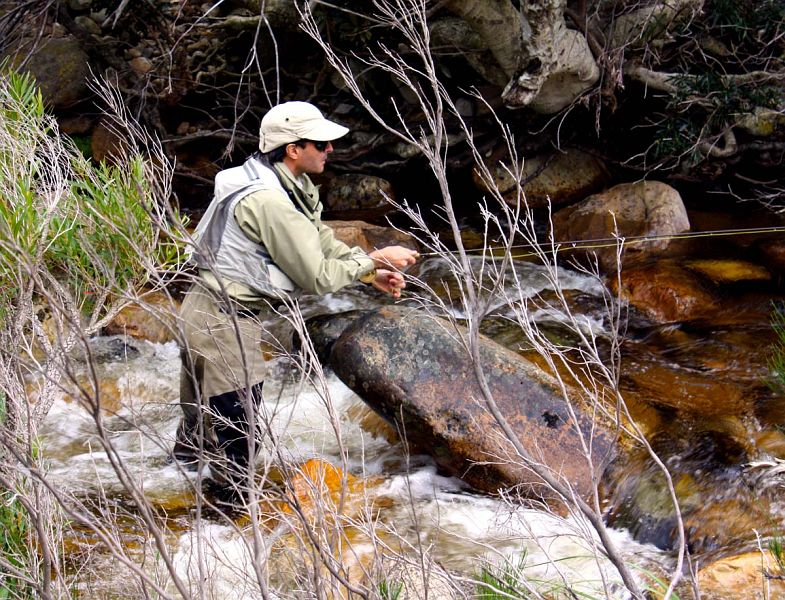
Luca on a Cape stream
(Luca Montanari is an accomplished salmon and trout fly fisher. Living in Italy he often finds himself on Italian chalk streams. In this article he shares six of his favourite flies for streams and also gives their dressing. Luca in my view is the best tyer of traditional salmon flies in the world today. He’s very modest and won’t admit it, of course. After we had fished a Cape stream together he had Mark Krige and I enthralled with his tying skills and his innovative patterns. See more of Luca’s marvelous fly tying and his flies on his website at http://www.moscofilia.com/home-english.html)

Luca's tying of the Green Highlander
Bibione

In the spring, or in the heart of the summer, terrestrial insects often end up in the river accidentally and become an occasional meal for fish. Sometimes winged ants, or of other species of flying insects, fall in large number on the water, inducing trout and grayling into a feeding frenzy. I noticed this on some chalk streams in my region of Italy, when small swarms of bibionids, an insect of the diptera family, are caught by the wind and blown onto the river. For this kind of situation I developed the Bibione, a fly that I started to use not only when I found the real insects on the water, but also as a searching pattern. In fact, thanks to its brilliant coloration, the Bibione is easily spotted by fish in the fast water and quite often induces takes from aggression or out of plain curiosity.
HOOK: regular shank size 14 to 12
THREAD: Black
BODY: Yellow seal’s fur (or substitute)
WINGS: Tips of two blue dun cock hackles
THORAX: Natural grey cul de canard fibres mixed with blue dun cock hackle fibres
THORAX COVER: Golden pheasant tippet feather
CDC Brown Sedge
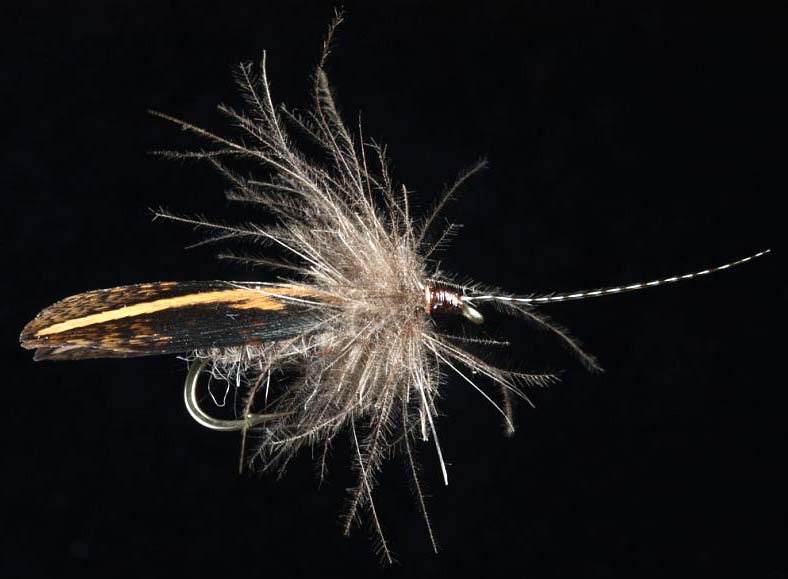
This fly is very successful when used on turbulent and fast rivers and thanks to the cul de Canard’s extraordinary floating abilities, allows for constant visual contact while it’s floating over rising trout.
The CDC Brown Sedges is one of the dry flies I prefer for my summer fishing, when the caddis became very active on the water surface in many Italian rivers. Its wings are made with two partridge, or woodcock, wing feathers. I like them both for the strength they lend to the wings during the stresses of casting and playing of fish, but also because they have excellent imitative qualities for several species of trichoptera.
HOOK: Long shank size 16 to 12
THREAD: Black
BODY: Dubbing of reddish/brown polypropylene
WINGS: Partridge or woodcock cover wing feathers
THORAX: Natural beige cul de Canard feathers, hackle natural red and lastly, brown dyed opossum hair trapped and twisted in a dubbing loop
ANTENNAE: Two fibres of pheasant tail or mallard shoulder feather
Emergente in Capoc
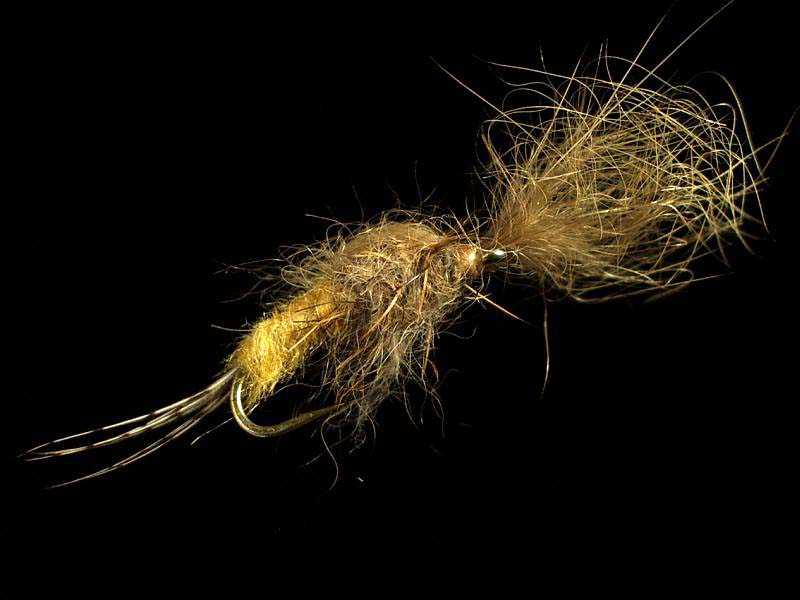
I developed this emerger to imitate a particular Baetis mayfly of an ochre yellow color quite common at the beginning of the summer on my home rivers. I like its buoyancy and the wings keep the pattern well visible in the surface film, even after a long fishing session. These are ideal qualities in emergers, making the Emergente in Capoc ideal also for fishing turbulent rivers, places where I like my fly does not sink completely, so as to induce the fish to rise and still give me time to strike.
(Kapok fibre is the seed hair from a Kapok tree and is sometimes referred to as ‘silk cotton’, or ‘Java cotton’. The fibres are described as yellowish brown, lustrous and lightweight. I have not been aware of its use until now in fly tying. Tom Sutcliffe.
See http://www.britannica.com/EBchecked/topic/311770/kapok)
HOOK: Caddis size 18 to 14
THREAD. Beige
TAI:. Partridge hackle fibres
ABDOMEN: Kapok dyed ochre yellow
RIBBING: Natural red cock hackle quill
THORAX: Hare’s fur
WING TUFT: opossum hair dyed of pale brown, or natural grey
Moscerino Fiammeggiante
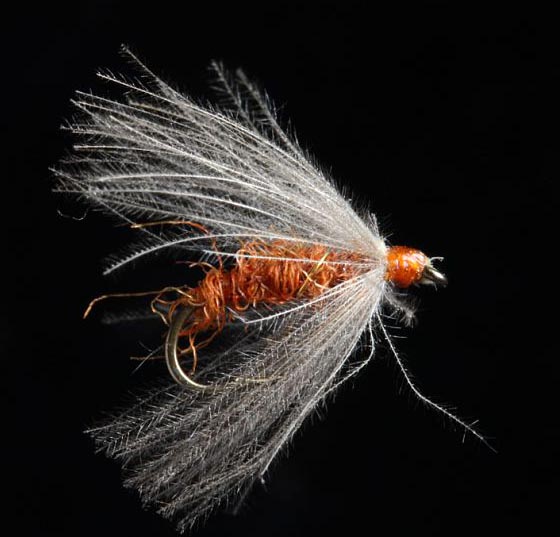
Because of its small size, this fly is easily taken by a trout or a grayling as a small midge, but also as a tiny spent mayfly. These qualities can contribute to some doubt in a fish’s mind, inducing it to give the fly a quick bite to check if it is edible. The result gives me a fleeting chance to hook a really big and selective grayling, but also large brown trout that have refused other fly patterns I have shown them.
HOOK: Regular shank size 20 to 16
THREAD: Fiery brown
BODY: Dubbing of fiery brown polypropylene
RIBBING: Fiery brown thread
COLLAR: Natural grey cul de Canard fibres
Reverse Spinner
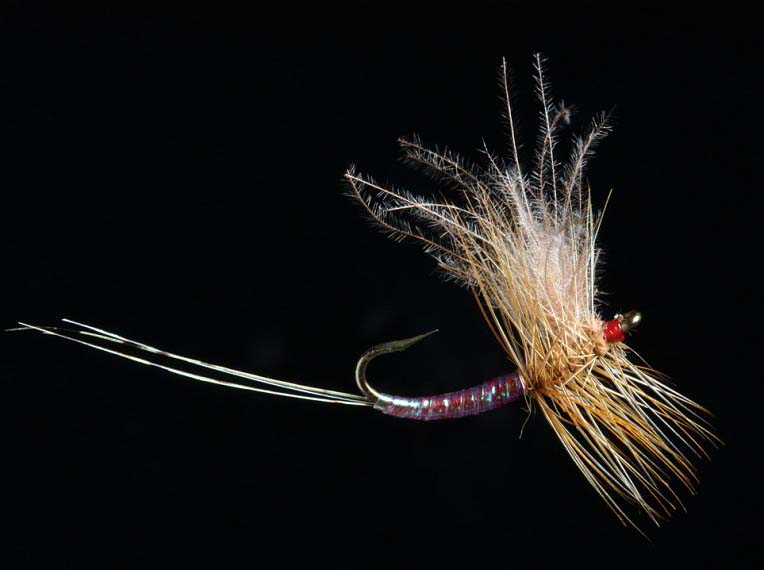
This fly is an imitation of a small upwing fly at the spinner stage, such as an Ephemerella ignita, or a Baetis. These insects are common on European waters and hatch in spring and summer. The most evident characteristic of the Reverse Spinner is the hook position, which is inverted. When the fly lands on the water the hook appears upside down with the point facing upwards and the abdomen – to the fish’s eyes – hides the hook bend. In this way I find the fly does not alarm fish in a way that I find sometimes causes a refusal on a chalk stream. Often the trout take this pattern even after showing reluctance to accept more traditional dry fly patterns.
HOOK: For caddis imitation size 18 to 14
THREAD. Red
TAILS: Coq de Leon
ABDOMEN: Pearlescent tinsel
WING: Light brown cul de canard
THORAX: Dubbing of light brown arctic fox fur
HACKLE: Natural red
Yellow Micro Gold Head
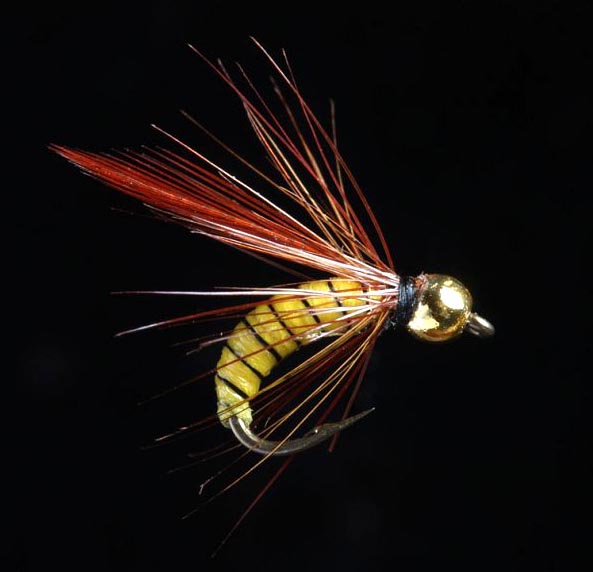
I conceived the Yellow Micro Gold Head for reservoir fishing, but I discovered that this fly is useful on many chalk streams, especially when the trout are feeding on small midges in the pupa stage. Its imitative qualities are quite poor, but its capacity to reflect the sun light, to vibrate its delicate fibres when it swims in the water and to appear like a small and vulnerable prey, often provoke an instinctive take. This nymph is very attractive to trout, but can be used as well for grayling, where I use it as the middle, or the top dropper, of my nymphing rig.
HOOK: Grub size 18 to 16
HEAD: A small gold plastic bead
BALLAST: Fine lead wire
THREAD: Black
BODY: Yellow floss
RIBBING: Black thread
WINGS and COLLAR: Natural red cock hackle
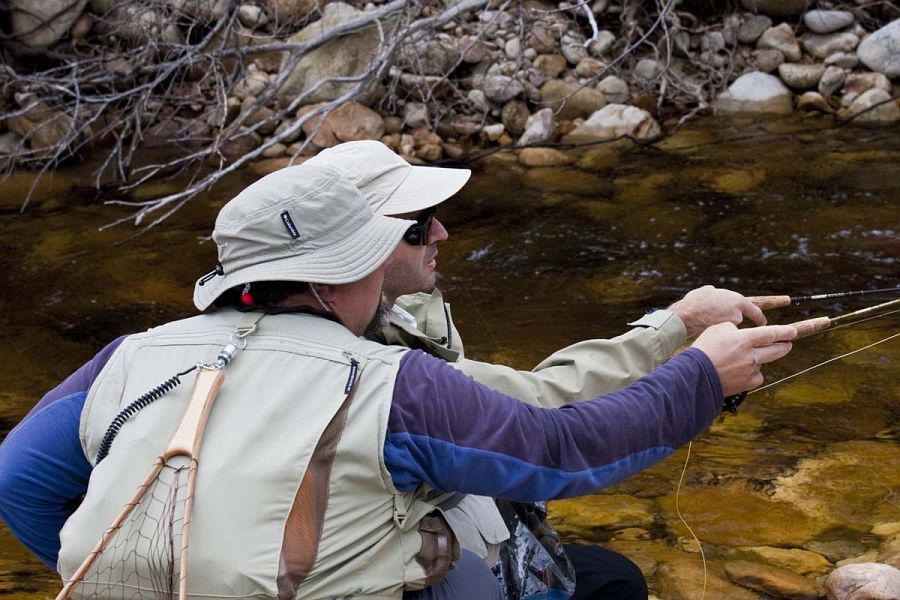
Luca and Mark Krige on a Cape fly stream. That evening he tied up some of his patterns for us.


